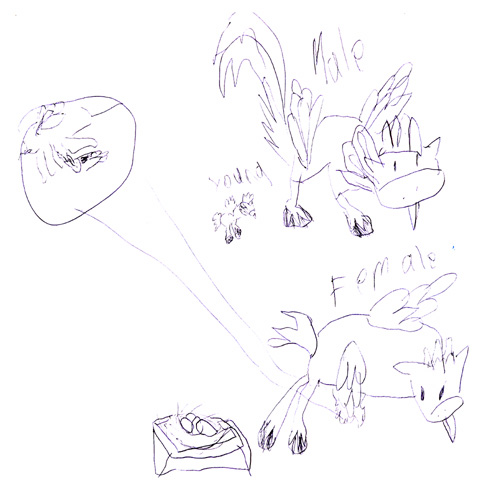The Free-Ride offspring are currently engrossed in a “creative dramatics” workshop, wherein they are learning all sorts of things about acting, characterization, costuming, and related matters in order to write, rehearse, stage, and perform a play. My kids are show people! Except that somehow, even when they’re being show people, the science wheels in their heads are still turning …
Younger offspring: We did an exercise where each group came up with a scene about one of the four food groups.
Elder offspring: My group did “dairy”. I was a brown cow who needed milking.
Younger offspring: My group did “meat”.
Dr. Free-Ride: And you a vegetarian! What were you in the scene?
Younger offspring: I was a cow that was used to make the cow-chicken.
Dr. Free-Ride: Say what?
Elder offspring: A cow-chicken. Half chicken, half cow.
Dr. Free-Ride: OK, tell me more about what went on in this scene.
Younger offspring: In the story we did, I was the cow, and someone else was the chicken, and the scientist made us put together, and then it became a cow-chicken when he said some scientific words.
Dr. Free-Ride: That almost makes the scientist sound like a magician!
Younger offspring: Well, maybe it’s not true that it would work that way, but I don’t know how it would work.
Elder offspring: It’s genetic blending!
Younger offspring: Oh yeah, he did blending.
Dr. Free-Ride: With, like, a blender?
Elder offspring: No, genetic combining.
Dr. Free-Ride: Gene splicing? You know, you can splice the genes and put them together, but you still need to grow the organism that results. Probably in an egg or a uterus or something.
Younger offspring: We didn’t do that part in our scene.
Dr. Free-Ride: OK. What are cow-chickens like?
Younger offspring: The cow-chicken has a chicken head and a chicken butt, but a cow body and a cow udder.
Elder offspring: They’re useful because they provide meat, eggs, and milk.
Dr. Free-Ride: What do they eat?
Younger offspring: Cow-chickens eat grass and chicken feed.
Elder offspring: Corn, hay, seeds, barley.
Younger offspring: Anything that a cow eats and anything that a chicken eats.
Dr. Free-Ride: Wow, so they can go either way. Now, I know that cows usually have how many stomachs?
Both offspring: (in unison) FOUR!
Dr. Free-Ride: And chickens have something called a crop that’s involved in the mechanical breakdown of their food. So what’s the situation with cow-chickens?
Elder offspring: I think the cow-chicken has two stomachs. One to store the food for later, because any animal could attack the cow-chicken while it’s eating. When it’s somewhere safe, the cow chicken can regurgitate the food and chew it till it’s nice and chewed. Then in the second stomach it’s digested some more.
Dr. Free-Ride: I see.
Elder offspring: Actually, because they have beaks, cow chickens don’t really chew their food. They just chop the food up to smaller bits with their beaks and then swallow it. They swallow pebbles that stay in the second stomach and help break down the food. And then, after the digestion …
Dr. Free-Ride: A fabulous source of rich cow-chicken manure!
Younger offspring: Eww!
Dr. Free-Ride: What do cow-chickens say?
Elder offspring: “Mawk” or “boo”.
Younger offspring: No, they say, “Moo-BAWK! Moo-BAWK! ”
Elder offspring: The young are fed on milk, which means the female cow-chicken’s udder is tough and doesn’t have nerves, because those beaks would hurt.
Dr. Free-Ride: Basically, we have a critter with a beak and feathers that’s drinking milk and that has some fur. So it’s like a bird that’s also a mammal?
Elder offspring: Yeah, but cow chickens can’t really fly.
Younger offspring: Neither can penguins, and they’re birds.
Elder offspring: Turtles have beaks, and they’re not birds. Also, a duck-billed platypus has a beak and is hatched from an egg, but it’s a mammal.
Dr. Free-Ride: So a cow-chicken might fit in with the mammals … except for the feathers. Those might complicate the proper categorization of the cow-chicken.
Elder offspring: It’s up to the scientists to classify it.
Of course, we have pictures:


We also have foreshadowing from two years ago. Yikes!

Your kids are AWESOME. But you already knew that. 🙂
=LOL= Your kids always crack me up!
A cow-chicken? Well, why not? Dogcows have been around for 20 years or more, ever since the first Macintosh computer.
Beautiful post – I can’t wait for the book!
The foreshadowing? Scary!
IIRC, Wesley Willis has a song about a chicken-cow. Probably not appropriate for children though.
German engineers have a wonderful term which dates back to around 1970: “eierlegende Wollmilchsau”, which translates to “egg-laying wool-milk-pig”.
The idea is that it’s the farmer’s perfect animal. It gives you eggs, milk, wool and bacon. The trouble is, to get at the bacon, you cut off your supply of milk, wool and eggs. The moral of the story is that the person or thing that can do anything can’t do everything.
Sometimes you’ll see job advertisements for creative people with good public speaking skills and so many years’ experience in X, Y, and Z. Such employers are said to be looking for an eierlegende Wollmilchsau.
Similarly, the term can refer to a device or software which has lots of features, most of which aren’t used or even useful. An example is a smart phone which is a phone, organiser, address book and games platform.
This sounds like what happens to my 1 year old when he’s playing with his Leapfrog fridge-barnyard toy. You put a chicken head on the left and a cow butt on the right and it sings a silly song about a chicken-cow! Well, actually, they don’t have a chicken head, but you could easily substitute the duck head that IS available as a reasonable facsimile. A duck-cow! *QUACK MOO* That’s silly!
I digress…